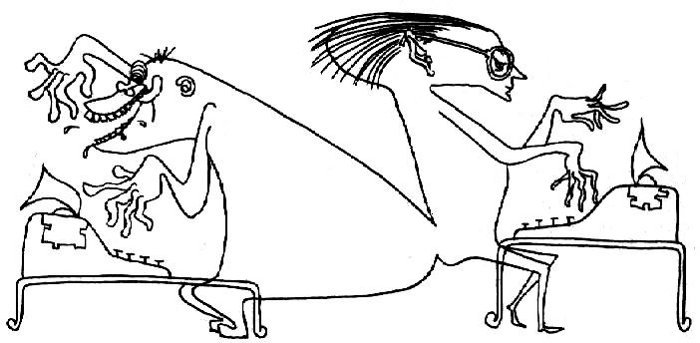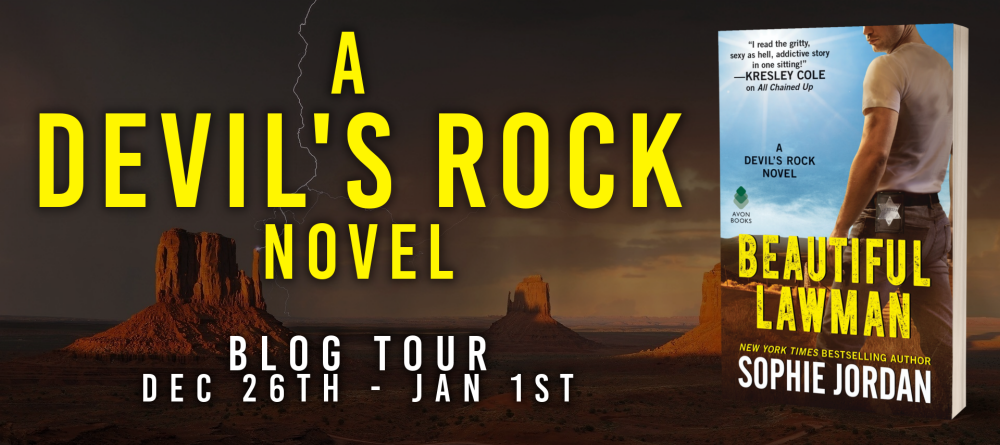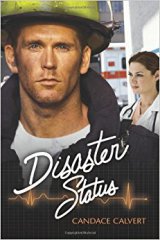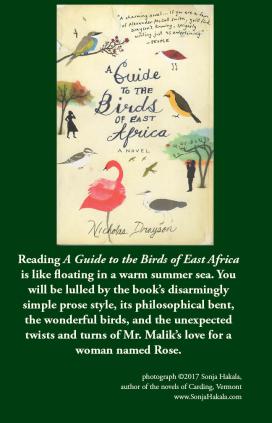Robert Bloch & Alfred Hitchcock were plotting against us.

Horror Bloch & Mystery Bloch Tag Teaming On Psycho
Last year a cinema local to me devoted Sunday afternoons to showing classic films. Among these hits of yesteryear were the Alfred Hitchcock films Psycho and The Birds. I made sure to attend both those showings because I’d never seen Psycho on the big screen and The Birds not at all. Much as I enjoyed re-watching Psycho and picking up on details not obvious on the small screen it was Hitchcock’s version of The Birds which most piqued my interest most. While I’d read the Daphne du Maurier novelette the film is based upon several times the only part of the film I was familiar with was the scene in which Tippi Hedren is trapped in a phone booth by attacking seagulls. Despite how dramatic this scene is it helped convince me that Hitchcock’s film would be lacking the brooding menace of the story was based upon and thus a bit of a let-down.
Having at last seen the film version of The Birds I find I was right to assume that a 1963 Hollywood production, even with Hitchcock at the helm, could not match the power of du Maurier’s original. Overall I thought The Birds was okay, certainly better than I had assumed it would be, but still not great. I can see why Hitchcock made so many changes as I doubt that in 1963 a more faithful translation of the story would sell tickets, but I can also see why Daphne du Maurier hated what he did to her story. I didn’t hate it myself but I did think it was the least impressive Hitchcock film I’ve ever seen.
None the less I was fascinated the way Hitchcock started off the film with a light romance that had nothing to do with du Maurier’s story and didn’t begin to introduce anything by du Maurier until the romance plot was well advanced. Why did he take such an unexpected approach I wondered as I watched this story unfold? Afterwards however it occurred to me that Hitchcock began The Birds the way he did in order to replicate the success of Psycho.
This theory of mine starts with not with Hitchcock but Robert Bloch for it was he who wrote the 1959 novel Hitchcock turned into his famous film. One of the interesting things about Bloch as an author is that while he wrote a large number of short stories he produced relatively few novels. Part of this is probably because while the majority of his pulp contemporaries shifted to writing novels during the 50’s as the fiction magazines were steadily replaced by paperbacks Bloch moved into script-writing instead. Possibly Bloch never felt as comfortable with the novel length and had no great need to overcome this due to his script-writing income.
Perhaps this is why Psycho is not a lengthy novel. The copy I have here is a mere 98 pages long which was short for a paperback even in 1959 (though to be fair comparable in length with many of the ‘novels’ that appeared in the fiction magazines back then). Moreover Psycho reads to me like two short stories linked together by that famous shower scene. Why the novel should have this rather unusual structure I can’t say for certain. Perhaps Bloch was using this as a deliberate ploy to ease himself into an story length he wasn’t entirely confident in. Perhaps Bloch decided to link two story fragments together because he couldn’t make a satisfactory stand-alone story out of either. Whatever the reason the fact is Psycho is greater than the sum of its parts because of the way those parts are fused together.
The first part of the novel is classic example of what I like to call the morality tale of horror. Such morality horror tales begin with the the protagonist transgressing in some manner. Sometimes the protagonist commits a crime, sometimes they knowingly or inadvertently cause some offence. However they have transgressed the protagonist then attempts to escape punishment by taking a series of actions. However in the morality tale of horror every attempt to avoid retribution leads the protagonist a step closer to their ultimate, ironic, fate. Classically these stories end by making it clear that the only reason the protagonist met their gruesome end was due to their efforts to avoid punishment for the initial transgression.
In Psycho, Robert Bloch’s morality tale, after a little scene setting and misdirection at the Bates Motel we are introduced to the person we assume is to be the main protagonist, Mary Crane, secretary for the real estate agent Mr Lowery. The plot proper begins when she is tempted into committing the crime of theft when Tom Cassidy presents Mr Lowery with a large sum of money and Mr Lowery asks her to bank it for him. Instead she packs her bags and flees town with the money, heading to Fairvale where her boyfriend lives. With the stolen money she then begins to sell and buy cars as she travels in the hopes of covering her tracks. However Fairvale is a long way away, eighteen hours on unfamiliar roads and not surprisingly she takes a wrong turn. After having realised her mistake Mary Crane decides to stay the night in a hotel somewhere and find the right road in the morning so she can arrive at her boyfriend’s hardware store in a more composed state.
That’s when she spots the secluded Bates Motel and sets off the sequence of events that leads to the shower scene.
Now if this had been a typical Bloch morality horror short story appearing in Weird Tales I imagine that the final scene (not necessarily in the shower) would reveal the hotel was a base for cultists willing to use Mary Crane as a sacrifice, a home for werewolves willing to have her as a meal, or some other horrible fate that she could only suffer by arriving at such an unlikely location.
However such an immediate conclusion was clearly not possible given Bloch was writing a novel, albeit a rather slender one. So instead Bloch simply leaves the abrupt end of his horror story up in the air. Who murdered the secretary and why? We have no idea though perhaps some suspicions. Anyway, upon the death of Mary Crane, the original protagonist, Bloch the horror writer retires to his corner and Bloch the writer of mystery stories takes control and brings her boyfriend, Sam Loomis, and her younger sister Lila to the fore. From this point on the story becomes a fairly straight forward problem solving plot as Sam and Lila attempt to discover the whereabouts of Mary Crane. Even the final reveal isn’t an especially uncommon plot twist. It does have some added impact when the killer’s thoughts are revealed to the reader but even that isn’t much of a surprise to the average reader of Weird Tales.
Now clearly Alfred Hitchcock grasped that it was the abrupt twist in the middle of the story which made this book so worth turning into a movie. Consider how much he built up the initial misdirection by having Marion Crane (no, I’ve no idea why her first name was changed) briefly encounter Tom Cassidy as she flees town and then by having her arouse the suspicions of sheriff Al Chambers. By the time Marion Crane arrived at the hotel anybody not familiar with the book would be primed to assume the rest of the film would revolve around a cat and mouse game between Crane and sheriff Al Chambers. For anybody not familiar with the book and who didn’t recall the hints dropped in the trailer (in other words the majority of the initial film audience) the shower scene must of been a devastating revelation.
This leads me to my theory that Hitchcock liked this misdirection so much that he decided to reuse the idea in The Birds. I would recommend that anybody who hasn’t read the Daphne du Maurier novelette should go and do so because it’s an excellent story. Just be warned though, it’s every bit as bleak a story as I suggested earlier. Indeed, so dark is it that Hitchcock had to change a lot of the detail to make the story palatable to the average film goer (that is apart from the traditional shifting the story to the US as would of happened regardless). He decreased the feeling of isolation by including a cast of bit-players, he reduced the threat level by having the avian aggression intermittent rather than constant, he removed the sense of hopelessness by having it made clear that the bird attacks were only localised.
Of course the danger with all this downplaying of the danger is that the threat might not feel big enough to properly scare the audience. So why not repeat the success of Psycho by starting the plot in one direction and then twisting it in another. In the case of The Birds the change in direction from the sunny uplands of a light romance to the darker and considerable more fraught survival story was less abrupt (well most things are less abrupt than Psycho’s shower scene) but effective none-the-less. By, hopefully, getting the audience invested in the light romance plot and resulting domestic drama I suspect Hitchcock hoped to make the introduction of the bird attacks feel like more of a tonal shift and thus more alarming. It also had the advantage of helping to stretch out the plot. For all the power of Daphne du Maurier’s novelette there isn’t a lot of plot to it so Hitchcock was was rather neatly killing two birds with a single stone.
Killing two birds with a single stone. That’s certainly one way to describe such plotting.
Share this:




